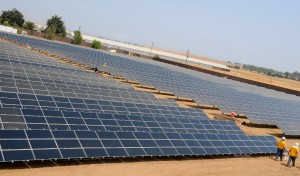Bigger and Better
The 1,000-volt inverter has officially been certified for more than a year, providing ample opportunities for larger and cheaper solar farms.
A little more than a year ago, North America was introduced to the solar industry’s new star — the 1,000-volt inverter. The product, first presented by American Electric Technologies Inc. (AETI), appeared to be in a league of its own until more and more inverter manufacturers followed suit.
“When we introduced the 1,000-volt inverter, we were sort of out on the dance floor by ourselves. When you get some other people dancing, the party gets a little more interesting,” says Kent Breaux, global director of renewables sales and marketing at AETI. “What that means for us is that the market has been validated. That comes with a lot of goodness for the overall market and AETI.”
 The last year has been a learning curve for inverter customers, getting them to understand the benefits of a larger inverter.
The last year has been a learning curve for inverter customers, getting them to understand the benefits of a larger inverter.
“When we first introduced the product, although it was widely accepted as the standard in Europe, in the U.S. there was very little education about what that meant in terms of implications you had,” Breaux says. “People were hesitant to actually deploy them for fear of them not making inspection. I think over the past year, you now see we don’t have the same questions.”
Mostly EPCs, utilities and independent power producers are looking for the 1,000-volt inverter — it’s obviously tailored to larger projects. The cost savings associated with a larger inverter (mainly from cable reductions) make bigger and bigger projects more reasonable.
SMA America has been shipping the Sunny Central CP 1,000-volt inverter family since 2009, but it didn’t enter the U.S. market (and become UL-listed) until May 2012. Ken Christensen, product manager of power plant solutions for SMA America, says the company decided to manufacture a larger, UL-listed inverter because of a strong demand from customers for a cost-effective product that offers a wide range of features.
“We saw a need to develop a solution that would work with both utility and commercial installations and would also provide advanced grid management functions,” Christensen says. “Most importantly, the 1,000-volt inverters provide substantial savings due to a lower balance of system cost while still delivering exceptional performance and high energy output with record-setting CEC (California Energy Commission) efficiencies.”
Advanced Energy began selling its own 1,000-volt inverter in 2009. It is not yet UL-certified, but, according to the company, that certification has only recently become a concern for utilities. AE has already installed the larger inverter in numerous utility-scale projects because developers are constantly on the lookout for ways to cut down on costs, says Mike Dooley, vice president of marketing with AE Solar Energy.
“As you start to get larger skids, the runs get very long and you’ll burn any savings in costs from going to a larger skid by having longer homeruns and longer amounts of trenching,” he says. “Right now, depending on the efficiency of the modules, a 2-MW skid is probably in the order of 10 or 15 acres of panels, which is a lot of panels. To bring all those homeruns back, that’s a lot of real estate to bring back. To go to an even bigger skid, maybe 4 MW, now you’re doubling that size and now these homeruns become very long and you have long line losses — it doesn’t make much sense.”
The solar industry can expect to see many 600-volt applications transition to 1,000 volts as more balance of system (BOS) components become available, says Christensen.
“We anticipate that the economic benefits of 1,000-volt PV systems will drive market adoption,” he says. “SMA believes 1,000-volt systems will displace many 600-volt systems. These inverters will bring down the overall cost of PV systems, and as costs come down, solar will likely become more favorable as an economical, cost-effective source of renewable energy for commercial and utility power.”
The increased-voltage inverter has driven the panel market to improve quickly.
“In the U.S., there was a glut of lower-wattage panels, but those have largely cleared out,” Breaux says. “Now what you see is a lot of innovation in the panel market. All the panels at a minimum are 1,000-volt capable. You’ve got several vendors now that have above 400-wattage panels. That really calls for a 1,000-volt product just to make those projects work.”
A larger inverter just makes more sense for the industry.
“Now solar professionals have access to a product that produces more energy at a lower cost,” Christensen says. “With more 1,000-volt inverters, modules and other components becoming domestically available, integrators will be able to benefit from the improved performance and lower levelized cost.”
Rather than outright competing with each other, it seems that inverter manufacturers are pleased with where the industry is leading.
“It all has been for the good,” Breaux says. “The competition is good. It raises market awareness of the benefits of using higher voltages. I think it’s spurred the next round of innovation. It’s really got people thinking that we should go to the next one.”





I’d like to find a talented individual who designs and installs single family home solar installations in the Prescott Valley area of Arizona. I was looking for perhaps some classified ads in your mag but don’t see that option…